Poesy rings (sometimes spelled "Posy ", or "Posie" rings") are finger rings with short inscriptions and they were the most common type of ring in use since the Middle Ages. They take their name from the word 'Poesy' which is derived from the old French word poesie, meaning 'The art or composition of poetry' and this refers to the amatory inscription which this type of ring bears and which is usually in rhyme or "poesy".
Poesy rings were given by both men and women as an expression of regard, friendship, attachment, or even love. Although these rings were widely used in the Middle Ages they are now hard to find. The posies on medieval rings were usually inscribed on the outside of the hoop (which was flat). They reached their peak of popularity however in the 16th and 17th centuries when they were usually inscribed inside and the hoop was much more rounded and hence contained a greater quantity of gold. The wearing of words against the skin was believed to increase their poignancy
Mourning Rings: Bequests of gold rings were often made in Dorchester and Fordington Wills of this period. Most of these would be commissioned after the death of the person concerned with the will specifying the value, and accompanied by words such as 'in remembrance of me'. The recipients or the executors may have had these rings engraved, but this was not always stated as being necessary in the will. These rings are more correctly referred to as 'mourning rings'.
Some examples of bequests of rings:-
-
William CHURCHILL when he died in 1602 he left a death head ring to his daughter Amme BROWNE in remembrance of me
John GREENE when he died in 1614/5 gave 17 rings to various people which included "unto Mr Francis ASHLEY Esq and unto Mr John WHITE preacher for an assured pledge of my love one gold ring each to the value of twenty shillings with this inscription (Amico fideli nulia compapatio) "
-
Thomas DAVIDGE when he died in 1617 gifted a number of rings. One was to his nephew Thomas DAVIDGE which was 'a gold ring with a red and blue stone engraved with the heart in prose'. Another was 'a gold ring with a posie marked with the letter ' T ' and ' D ' which he bequeathed to his kinsman Elliott Johnson.
-
Margaret CHUBB when she died in 1628 gifted rings to the value of thirty shillings each to a number of individuals which included, ' Robert CHEEKE Minister and the son of the church of All Saints', and Mr John WHITE Minister and Parson of the church of St Peter and Holy Trinity in Dorchester - if he shall preach my funeral sermon' . Each of these rings was to be inscribed with the words "the gift of Margaret CHUBB"
-
Stephen WHITE (who was the younger brother of Revd John WHITE of Dorchester) when he died in 1629, gave rings worth thirty shillings each to all his brothers and sisters.
By the 17th and 18th centuries, most poesy rings were used as wedding rings. Although some of the inscriptions were originated by the donor, there were also a number of standard inscriptions which could be bought already engraved on the rings.
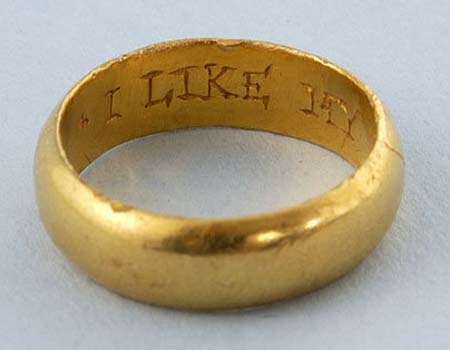
-
17th Century gold posy ring (c. 1600 England) The inside of the ring is inscribed:- * I LIKE MY CHOIES ONLY. Current value of ring £1,700
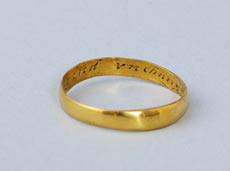
The ring is a little irregular in shape but this does not show when it is worn
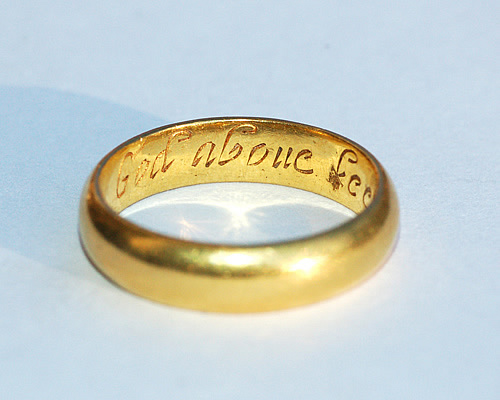
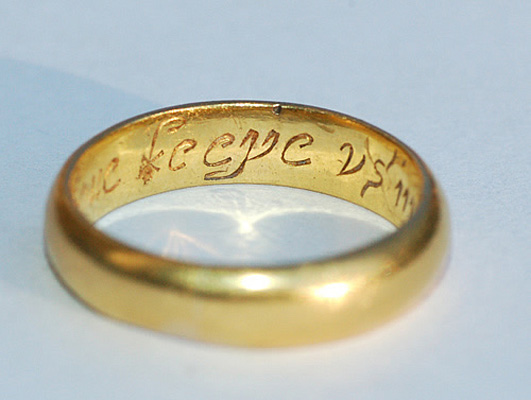
with the motto "God aboue keepe vs in loue" [God above keep us in love], in Italic script.
It is stamped with maker's mark WC.
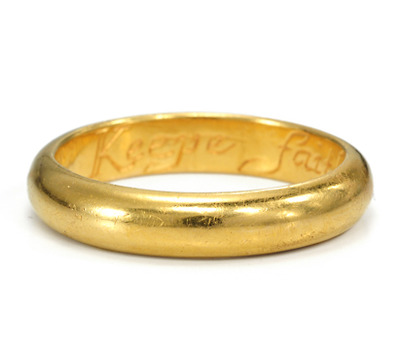
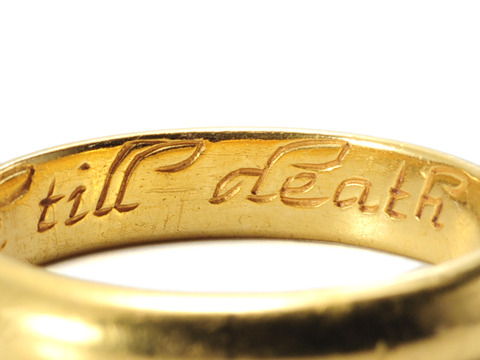
Links List of poesy phrases
The following is a list of Poesy Phrases found on rings by the Jeweller's Wartski Ltd.
14 Grafton Street,
London,
W1S 4DE and I have provided a link to the listing above which includes additional pictures of many of the rings. Parts of this site however are already (Dec 2012) inaccessible so I have reproduced the listing below to prevent their loss as I think they provide a useful insight as to how these rings were used.
‘A+DVTIFVL+SERVANT+DESERVED+REWADS+'
'A Frindes gift'
'A+FRIENDE'S+ GIFTE'
‘A true friends Gift'
‘A Vertuous wife preserueth life '
'After consent ever content'
‘x AMICVS x TVVS'
'I love you.''
'As God decreed soe wee agreed'
' As gold is pure, so love is sure'
'As I prove I wish your love'
'Be true in Harte'
'Bee firme in faith'
'Better Neuer than not euer'
' CERT A MON GRE '
(certainly my choice)
‘Content is a treasure'
'Continew Faythfull'
'EN MI MARIE'
(to my husband)
'Far of yet not forgot'
'Feare god love thy choyse'
'Feare not mee, i'le faithful bee'
'God above increase our love'
'God made us two one'
‘God send me always of his grace'
'Harbour a harmless [pictogram of a heart]'
'Harbor the harmless hart'
'[pictogram of a heart] and hand at your command'
'Harts United Live Contented'
'Hearts United Lives Contented'
'I am free for God & Thee'
'I cannot show the love I O'
'I give it the to think on mee'
' I have obtained whome god ordained '
'I x LIKE x MI x CHOYSE'
'I LIKE MY CHOIES ONLY'
'I like my choyce' '
'I like my choyse'
'I live in Hope'
'I love and like my choice'
'I rejoyce in the my choice'
'I with your pretty sight, will breed you much delight'
'In Christ and thee my comfort be'
'In love abide till death devide'
'In loyalty Ile live and dye'
'In thy breast my heart doth rest'
'In thy brest my heart doth rest'
' In thee my choyce I do rejoyce'
'In thy sight is my delight'
'Let the Lord above send peace & love'
'Let this present my good intent'
‘+ LET + TRVTH + TRYALL +'
'Let love continue'
'Let us share in joy and care'
‘Let us share in Joy and Care'
‘Let vertue rule affection'
'Let vertue still direct thy will'
'Live & Love'
'Live in Love & feare the lord above'
'Love is the bond of peace'
'love never dies where vertu lies'
'Loue to be louved'
'Love vertu'
'Moe love to Myne' More love to Mine'
'My gift is myselfe'
'my hart is thine'
'My love by this presented is'
' My .loue .to .the. sal. endless. be '
My love to thee shall endless be
‘No gift like good will'
'No riches like content'
'Noe recompence but love'
'None Can Preuent the Lord's Intent'
'Not the vallue but my love'
‘Of earthli joyse thou art my choys'
‘Oh hurt noty [heart pictogram] whose only joy thou art'
'PIU*FA*TEMPO*CHE*FORZA'
'Rather dye then faith denye'
'Remember the giver'
‘Sith hands and hart with one Consent
let nought but death the Knot preuent'
‘Some love in earnest, some in jest,
I love her thatt I like best'
'The god of peace our love increase'
'* THE HART SAW * THE LOVE CHOSEN *
* NEVER BROKEN * JOYND ETERNAL *'
'The Lord us Bless with Good Success'
'The loue is trew that I O U'
'The Love of thee is life to me'
'The ring is round & hath no end so is my love for thy'
'True love is endless'
'True love will not remove'
'TRYFULL+NOT+WYTH+THE+TRUSTY++'
'UBI AMOR IBI FIDES'
Where There is Love There is Faith'
'United hearts death only parts'
'Vertue paseth ryches'
'Wee joine our harts in God'
'Wee joyne our love in God above'
'When this you se remember me'
'Yield and Conquer'
'You and I will Lovers dye'
'You have my hart'
‘You never knew a heart more true '
'+YOURES+TO+DEFE+'
Examples of a bequests of a death head ring:-
-
Willaim CHURCHILL when he died in 1602 he left a bequest in his will "I give to Anne BROWNE my daughter a ring of twenty shillings value with a deathes head on it, for remembrance of me --" he also gave two death head rings valued at 40 shillings each to the Overseers of his will -- his brother in law Richard SWAINE and Cousin Thomas FREAK
Oliver HAYNE when he died in 1623 left a bequest in his will for a death head ring to the value of twenty six shillings and eight pence each be made and delivered to his married daughter Mary PERKINS, his daughter-in-law Rawlin HAYNE, and his four overseers his friends Richard RIVES and William HEARNE, his son-in-law William PERKINS and his son John HAYNE
Ursula BALL when she died in 1642 she gave her death head ring to her daughter Ann ELLIOTT . The image below from the V & A collection is interesting as the ring appears to be both a memento mori ring, which reminds the wearer that she or he must die, and a marriage ring. The second inscription on the ring ('RATHER DEATH THAN FALS FAYTH' ) and the true lover's knot that unites the two initials suggest that it was used as a betrothal or marriage ring by 'M' and 'L', although we do not know who they were. The solemn vows of marriage are associated with death: 'till death us do part'. Whilst we cannot now tell what type of ring Ursula had this shows that it is possible that it was given to her by her husband Robert Ball after they married as a symbol of how seriously he took the marriage, (she left her wedding ring to another daughter) and perhaps this is why it held such significance to her that she bequeathed it to her eldest daughter.
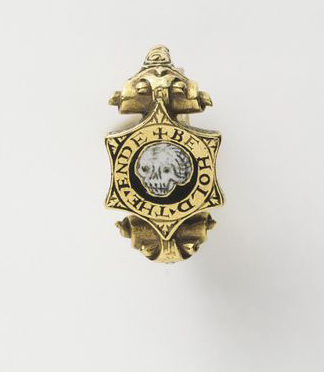
© Victoria and Albert Museum, London.
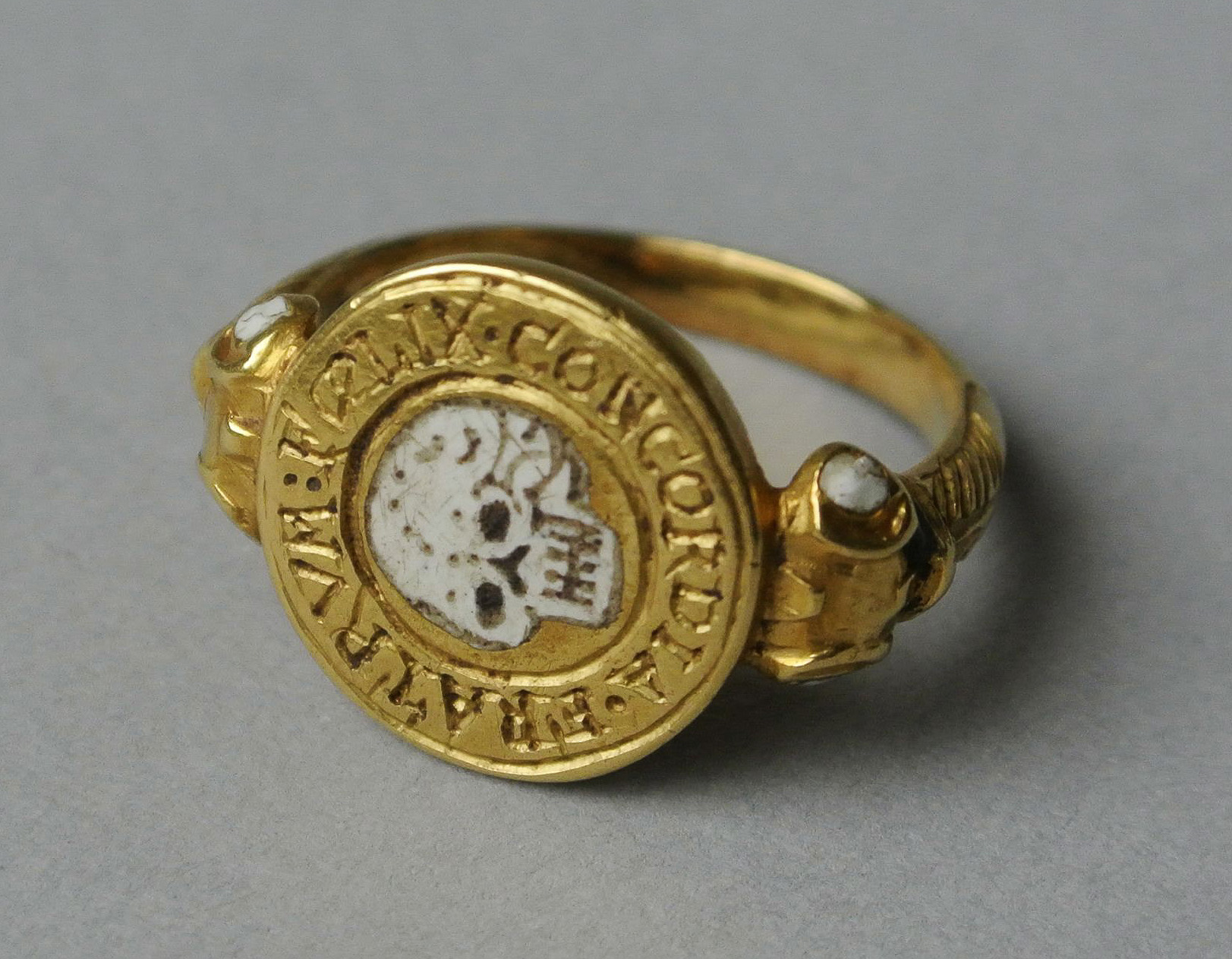
© Art of Mourning